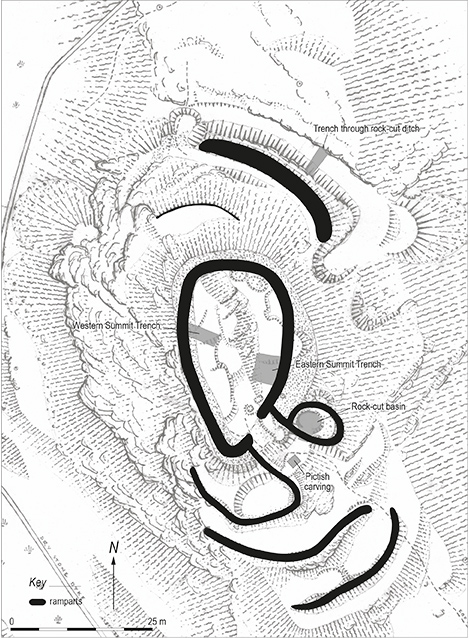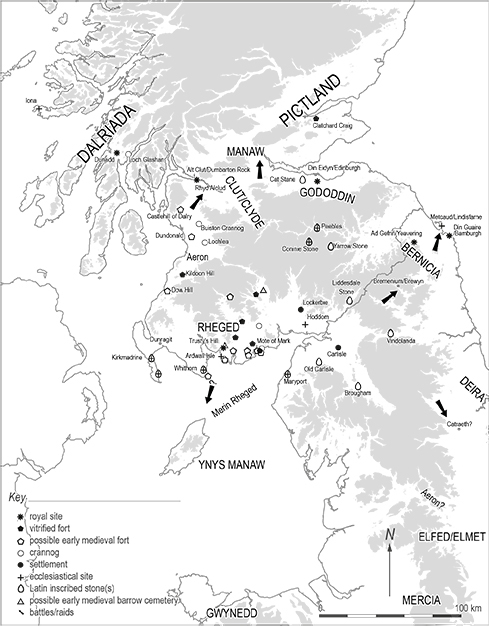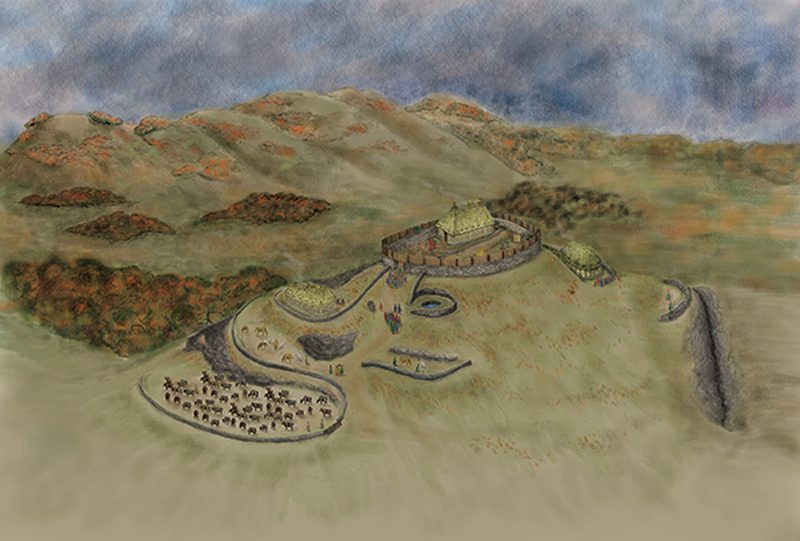Although there are plenty of examples of vitrified hill forts on the continent this offering is concerned solely with Scotland. They have periodically been of interest to neo-catastrophists on the basis there is a small chance they may have been vitrified as a result of fire from the sky (whatever that may entail). None of these forays have proved worth pursuing as C14 dates for vitrified forts tend to be all over the place (especially in the first few centuries AD). One can hardly advocate multiple atmospheric air blasts in a well recorded period of history. Archaeologists themselves have been divided. It was popular a few years ago to think in terms of purposeful torching of hill forts in order to strengthen the structures in some way. However, various excavations have tended to put this strange idea to bed as setting fire to the ramparts of hillforts was hardly an advance in building technique.
It is of course the word vitrification that has thrown catastrophists as it conjures up images of vitrified trees in geological deposits. The word here is misplaced. What has occurred is a deliberate attempt at destruction of the wood and earth ramparts that in some instances has generated so much heat that stones appear to show signs of melting. What kind of stones melt as a result of a good bonfire I don't know but possibly limestone or other sedimentary formations. Flints in a bonfire tend to go blue but remain largely intact. It has to be borne in mind that these hillfort ramparts are only partially burnt out – looking for the world like bonfires set along them.
This implies very strongly that vitrified hillforts are a result of deliberate human action. The question that might be asked – was the firing a result of malevolent action by an enemy or do they amount to ritual closure of the sites in question (the people moving on to pastures new). Ritual closure is a feature of British pre-history going all the way back to the Neolithic. Barrows were bunged up and entrances pulled down to stop people getting inside passage tombs etc. Even the roofbox at Newgrange was plugged – with a piece of white quartz. The Ness of Brodgar seems to have been ritually closed down with an enormous feast taking place at the same time. The practise continued into the Bronze and Iron ages. Many native sites were ritually abandoned in the 1st and 2nd centuries AD (offerings of pottery, animal bones and broken quern stones are quite common, in filled in ditches) and people moved their farms from the plateau edge into the valley below. There was a reason for this – the Romano British focus was able to shift as a result of the Roman Warm Period and a reduction in rainfall, in one case, but also Roman period settlement tended to congregate on the new road system they developed. It was no good being up on the hill when all the action was taking place below. After the Romans left some of the hillforts were reoccupied. This is because of a reversion to tribal politics and the expansion of kingdoms formerly kept in check by the Romans. In this instance it is the Kingdom of Rheged that has been under the microscope – go to www.pasthorizonspr.com/index.php/archives/01/2017/the-fiery-demise-of-a-…


After the abandonment of Hadrian's Wall in around AD410 and the departure altogether of Roman armies the kingdom of Rheged appears to have been quick on the mark in reforging its powerbase and expanded military in order to reclaim lost territories (in the Roman organisation of Britannia) and new pastures in the direction of the kingdoms of Bernicia and Deira. In the 5th and 6th centuries AD Rheged was at it's pogee and excavations have revealed extensive trade with Gaul (during the period when the western sea lanes were still active). Rheged has a legendary status in heroic literature of the Celts and this appears to apply to the immediate post Roman phase of history when it dominated lesser tribes in the vicinity. Bernicia and Deira were united and became the new kingdom of Northumbria – a rival to Rheged. It seems that Trusty Hill may have been the seat of the kings of Rheged and therefore a target of the Northumbrians who expanded into the southern uplands of Scotland (in order perhaps to protect their northern flanks). Trusty Hill met a fiery demise in the 7th century AD.
This is the gist of the article at the link above and also the theme of a new book by Ronan Toolis and Christopher Bowles, 'The Lost Dark Age Kingdom of Rheged' Oxbow Books: 2016. Evidence of Pictish contact has been found in Galloway but the authors do not think this means they were able to expand into the region as Rheged was too powerful. Instead, their northern neighbours (see map above) could have been in trade and social contact with them. The Picts were active in the 3rd to 5th centuries and this may have been due to rising sea levels (the Romano British Transgression event) but we should be a little sceptical of Roman writers who blamed everything on raiders from the sea when in retrospect it could easily have been masking Romano British disaffection with the Roman system and local acts of rebellion. Archaeology in the Pictish eastern side of northern Scotland is interesting in itself.
 … this is what Trusty Hill may have looked like.
… this is what Trusty Hill may have looked like.
